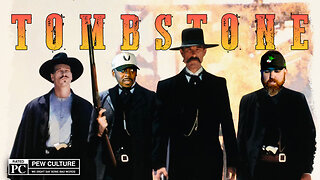Premium Only Content

The Kary Mullis Revelation: Unveiling the HIV-AIDS Connection and Fauci’s Role in a Medical Cover-up
In the vast and often labyrinthine world of science, there are figures who step beyond the boundaries of their field to challenge dominant narratives. One such figure was Dr. Kary Mullis, the Nobel Prize-winning biochemist and the inventor of the polymerase chain reaction (PCR) technique. He was known not only for his genius but for his fearless skepticism. And perhaps his most controversial critique was aimed at the connection between HIV and AIDS—a relationship most of the world accepted without question, but which Mullis began to dismantle as he dug deeper into the science. His target? None other than Dr. Anthony Fauci, one of the most powerful figures in American health policy.
The HIV-AIDS Paradigm: A Manufactured Consensus?
The dominant narrative surrounding AIDS is well-known: HIV (Human Immunodeficiency Virus) is the virus that causes AIDS (Acquired Immunodeficiency Syndrome), a devastating condition that emerged in the 1980s and claimed millions of lives. This understanding became medical dogma, pushed by institutions such as the Centers for Disease Control and Prevention (CDC) and the National Institutes of Health (NIH). But Mullis, a figure not easily swayed by institutional authority, began asking questions that few others dared to.
Mullis became deeply skeptical of the established view when he tried to find a scientific paper that proved HIV caused AIDS. To his astonishment, no such paper existed. In interviews, Mullis recounted how he consulted virologists and other medical professionals, asking them to point him toward the study that definitively linked HIV to AIDS. Time and again, he was met with vague responses or dismissed altogether. This led him to the realization that the foundation of this deadly epidemic might be based on shaky, or even fabricated, science.
“I started looking for the proof of the HIV-AIDS connection and found there was none. They had just made it up.”
The Role of Dr. Anthony Fauci
Dr. Anthony Fauci, a name now synonymous with American public health and leadership during the COVID-19 pandemic, was also a central figure in the HIV-AIDS crisis. At the time, Fauci was the director of the National Institute of Allergy and Infectious Diseases (NIAID), and his influence over the HIV narrative was profound.
Mullis did not mince words when discussing Fauci, whom he saw as a bureaucrat more interested in maintaining power than in fostering genuine scientific debate. Mullis suggested that Fauci, alongside other high-ranking officials, perpetuated the HIV-AIDS paradigm not because the science supported it, but because it was financially and politically advantageous. The CDC, which was in financial trouble prior to the AIDS crisis, saw a massive influx of funding after the disease was connected to HIV. Pharmaceutical companies also profited immensely from the narrative, selling drugs like AZT (Azidothymidine) that were claimed to be the best treatment for the virus but were later found to be highly toxic.
Mullis accused Fauci and others at the top of silencing dissenting voices, ensuring that the HIV-AIDS connection remained unchallenged in the public arena. To Mullis, the science had been hijacked by financial interests, and anyone who dared to question the narrative was marginalized.
The PCR Technique: A Double-Edged Sword
The irony is that Mullis’ own invention, the PCR test, became a tool used in diagnosing HIV. However, Mullis was vocal about the misuse of PCR in this context. He emphasized that PCR, while incredibly effective at amplifying tiny amounts of DNA, should not be used as a diagnostic tool for detecting viral loads. In his view, PCR could detect fragments of a virus, but this did not mean that the virus was actively causing disease in a patient.
He believed that the widespread use of PCR to diagnose HIV was misleading and contributed to the false narrative that HIV was the sole cause of AIDS. Mullis’ critique of how his invention was co-opted by the medical establishment adds another layer of complexity to the HIV-AIDS story. His invention, intended as a research tool, became central to a global epidemic’s diagnostic machinery, even though its inventor opposed that application.
The Financial Motive: Following the Money
Mullis’ accusations were not just aimed at Fauci and the medical establishment, but also at the pharmaceutical industry. He noted how the declaration of HIV as the cause of AIDS coincided with a massive increase in profits for companies that produced AIDS-related drugs. AZT, one of the earliest and most widely prescribed drugs for AIDS patients, was developed as a chemotherapy drug and had severe toxic effects. Nonetheless, it was marketed as a life-saving treatment for those diagnosed with HIV.
The medical-industrial complex, as Mullis saw it, had a vested interest in maintaining the HIV-AIDS connection. The CDC and NIH received more funding, pharmaceutical companies sold more drugs, and an entire industry was built around the premise that HIV caused AIDS. Any dissent, such as Mullis’, threatened to undermine this lucrative system.
The Dangers of Questioning the Narrative
Mullis was not just concerned about the scientific flaws in the HIV-AIDS connection—he was also deeply troubled by the social and political implications. He believed that questioning the HIV-AIDS link was akin to heresy, with those who raised doubts being ostracized from the scientific community and labeled as dangerous conspiracy theorists. This, he argued, stifled genuine scientific inquiry and allowed a potentially false narrative to dominate.
Mullis’ suspicions that powerful figures like Fauci were willing to go to great lengths to protect their interests were not without merit. Over the years, various individuals who questioned the HIV-AIDS paradigm found themselves marginalized or worse. Some faced professional ruin, while others claimed that their lives were threatened.
Beyond HIV: What Does This Mean for Science?
The Kary Mullis saga and the HIV-AIDS controversy reveal deeper issues within the scientific and medical communities. The case of HIV-AIDS demonstrates how easily a narrative can become dogma when financial and political interests align. It raises the question of how many other “settled” scientific theories may be similarly based on shaky or incomplete evidence.
The legacy of Mullis’ revelations is a warning: science, when influenced by power and profit, can become a tool of deception rather than a beacon of truth. His challenge to the HIV-AIDS connection invites us to scrutinize all dominant narratives, particularly those that have far-reaching consequences for public health, policy, and human lives.
While the mainstream medical establishment continues to hold that HIV causes AIDS, Mullis’ critique remains a significant, though often ignored, counterpoint. His fearless questioning of authority and demand for rigorous scientific proof is a reminder that science should never be taken at face value, especially when the stakes are so high. In a world where profit and politics often guide decision-making, it is essential to remain vigilant and always ask the critical questions: Who benefits? What evidence is there? And, most importantly, what if they’re wrong?
In the end, the story of Kary Mullis and his battle against the HIV-AIDS establishment is more than just a medical controversy—it’s a cautionary tale about the fragility of truth in a world driven by power and money.
-
 1:09
1:09
FragmentsOfTruth
17 hours ago⟁ THE FREQUENCY KEY
1402 -
 8:41
8:41
nospeedlimitgermany
5 days ago $0.01 earnedBMW 316i E36 Compact 102 PS Top Speed Drive German Autobahn No Speed Limit POV
52 -
 25:38
25:38
Clownfish TV
14 hours agoAmerican Eagle Sydney Sweeney Situation is INSANE...
9559 -
 2:46
2:46
Blackstone Griddles
13 hours agoBetty's Breakfast Tacos on the Blackstone Griddle
4983 -
 2:23
2:23
The Quiet Part
15 hours agoCanada is no longer requiring immigrants to speak English?!
2024 -
 13:03
13:03
Dr Disrespect
3 days agoDr Disrespect’s BIGGEST Announcement Yet
106K43 -
 21:08
21:08
GritsGG
14 hours agoRank 1 POV - Spectating Solos!
5.21K -
 40:23
40:23
pewculture
1 day ago $3.39 earnedThis is the best western movie ever made! EP#25
15.8K5 -
 44:43
44:43
Omar Elattar
8 months agoAmerican Idol Finalist: “I Had No Plan B! - It Was Idol Or Nothing”
6.59K1 -
 58:56
58:56
The Connect: With Johnny Mitchell
1 day ago $30.77 earnedA Migrant Smuggler Reveals How Cartel Trafficking Works, WARNS Of Conditions At The Border
106K51